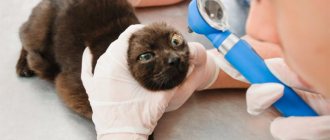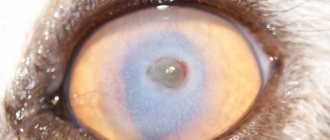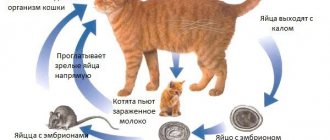Tearfulness, purulent formations in the corner of the eyes, inflammation of the eyelids and obvious anxiety of the animal associated with the eyes - such symptoms cannot but alert the responsible owner. Self-treatment in such cases is unacceptable, since the exact diagnosis is unknown. Most often, the owner thinks that the cat has ordinary conjunctivitis, but only a veterinarian can make a diagnosis.
The symptoms described above are characteristic not only of conjunctivitis. Similar manifestations may be accompanied by an inflammatory process in the cornea of the eye. A cat may also develop blepharitis, a dangerous disease whose advanced cases lead to partial or complete loss of vision.
Blepharitis in a cat
Description of eye disease
Blepharitis is a characteristic disease for cats; it is often confused with conjunctivitis - inflammation of the mucous membrane of the eye, because pathologies have similar symptoms. One disease can flow into another or be present in an animal at the same time.
Some pet owners underestimate the danger of blepharitis. If it is not treated or done incorrectly, the disease will become chronic, and then the eyelids may grow together and become deformed.
The development of follicular and purulent conjunctivitis is likely - the eye shell will become dry and vision will deteriorate. In some cases, the animal becomes partially or completely blind.
All cats are susceptible to blepharitis, but some breeds are at risk: these include animals with a flattened face - British, Persians, etc. The predisposition of breeds to the disease is associated with the structure of the tear duct and a hereditary factor. Such animals are predisposed to developing eye disorders.
Blepharitis can be contagious to both other pets and humans. There are various types of disease; if inflammation of a cat’s eyelids is caused by demodectic mites, the animal becomes a carrier of the infection.
There are other types of ophthalmological pathology: scaly, ulcerative, meibomian and allergic - they are not dangerous for humans and healthy pets.
The species differ in symptoms and sometimes in the causes of development. For example, an allergic eye occurs due to individual intolerance to a substance; a scaly eye can develop if the eye was injured after a fight.
Scaly
This is the most common type of blepharitis in cats and often develops into other forms of this eye disorder. First, they turn red and swell, and their edges thicken, and light gray scales appear in place of the eyelashes. Later, pus may be released and eyelashes may fall out.
Ulcerative
Often occurs after a scaly appearance. After the crusts of pus dry out and fall off, an ulcer appears on the surface of the eyelid - a wound that is a gateway to infection. The inflammatory process intensifies due to the ingress of pathogenic microbes.
With the development of ulcerative blepharitis, certain areas become scarred, which causes tightening of the skin - resulting in inversion or eversion of the eyelids. New eyelashes do not grow, so the eyelid does not cover the eye.
Meibomian
It develops due to excessive secretion of secretions from special glands, they are called meibomian glands. Such glands become swollen and inflamed when styes appear, and the edge of the eyelid becomes very thick and red. Soon pus appears, because... microorganisms managed to enter the duct of the meibomian glands.
Allergic blepharitis is accompanied by periorbital itching, hair loss and the formation of ulcers. Demodectic mange is manifested by the formation of crusts and severe redness of the skin, alopecia and severe itching begin in the area around the eyes.
Signs of blepharitis: a reminder for the owner
Symptoms of blepharitis in dogs and cats depend on its form, including scaly, ulcerative and phlegmonous. However, it is possible to identify general signs - those that are characteristic of all or several forms of the disease at once.
Common symptoms of blepharitis in dogs and cats:
- redness of the edges of the eyelids,
- hyperemia,
- thickening of the eyelids,
- itching,
- decreased visual function,
- temperature increase,
- formation of ulcers,
- sticking or loss of eyelashes,
- accumulation of exudate,
- formation of scales along the eyelash line,
- baldness of the eyelid edges,
- lacrimation,
- painful sensitivity of the eyes to light - photophobia,
- apathy.
Attention! Due to itching and constant discharge, animals scratch their eyes with their paws and rub against various objects, which is why injuries to the organs of vision are often observed.
If you notice one or more signs in your pet that indicate the development of blepharitis, then do not hesitate - make an appointment with a veterinarian in Moscow. The specialist will quickly diagnose and do everything necessary to restore the animal’s health!
Causes of eyelid inflammation
A cat's eyelids become inflamed for a variety of reasons:
- ingress of bacteria and viruses - blepharitis develops due to pyogenic cocci;
- demodicosis and sarcoptic mange - parasites and demodectic mites affect not only the face, but also the eyelids;
- fungi - causative agents of lichen and trichosporia;
- allergies to medications, food, etc.;
- eye injury after a fight or self-scratching;
- seborrhea - if the sebaceous glands are disrupted, scales appear on the eyelids;
- surgery to transplant the salivary glands due to poor production of tear fluid, because saliva is “more aggressive” than tear fluid.
Endocrine and autoimmune diseases can also trigger the development of blepharitis. The exact cause of the pathology should only be determined by a qualified surgeon - he makes a diagnosis after a clinical examination and examination.
What is blepharitis?
Blepharitis is an inflammation of the edges of the eyelids, which can occur in acute or chronic form. Infectious and inflammatory eye diseases in cats are caused by viruses or bacterial pathogens. Allergies, decreased immunity, metabolic disorders, chronic infections and injuries (scratching, scrapes, bites) contribute to the disease.
The cause of blepharitis in cats can be parasites - subcutaneous mites, as well as fungal pathogens of ringworm or seborrhea, in which the functions of the sebaceous glands are disrupted and dandruff appears on the eyelids. More often, the infection affects weakened animals after suffering from respiratory diseases, anemia or digestive disorders.
Symptoms and diagnosis
Each type of blepharitis has its own symptoms, but there are basic ones:
- redness of the eyelids;
- severe itching;
- swelling;
- lacrimation.
When diagnosing eyelid inflammation, the doctor examines the animal using a slit lamp and takes a medical history. Then various studies are carried out:
- flushes;
- blood analysis;
- tissue biopsy.
It is necessary to make a correct diagnosis, because... Blepharitis is easily confused with other ophthalmological diseases, such as conjunctivitis. It is necessary to determine the cause of weakened immunity.
Blepharitis: Which breeds are prone to it?
Our beloved Persians, Himalayan and Burmese cats most often suffer from eye diseases. Unfortunately, for the above breeds, this is a hereditary disease in which the eyelids cannot close completely. As a result, the eye is constantly under tension, which leads to irritation. Against the background of this feature, dermatitis, inflammation of the eyelid, conjunctivitis, and, finally, blepharitis appear.
In order to prevent the development of such a disease, wipe your cat's eyes several times a week with a decoction of medicinal herbs, such as chamomile or calendula.
A breed such as the Sphynx has a congenital bend in the eyelid, which occurs due to improper formation of epithelial tissues during the embryonic period. For this reason, the cat suffers from rubbing its eyelids against each other. Such cases, unfortunately, are the most difficult. If blepharitis occurs in such eyes, the only way to combat the disease is through surgery.
Protective cap for cats against eye scratching
Treatment regimen
Treatment of inflammation of the eyelids includes an integrated approach, carried out under the supervision of a veterinarian. Pathology therapy is aimed at combating the cause of blepharitis.
Drops and other drugs
If the disease is associated with the ingestion of microbes, the doctor prescribes immunoglobulins and antibiotics. For viruses, he prescribes drugs to combat them.
If ticks are detected, treatment will be long; for several months you will have to fight demodicosis or sarcoptic mange in your pet. You will need to remember precautions - such infections are transmitted to humans.
If the cause of blepharitis is a fungus, the fight against it will be protracted. For trichophytosis, vaccination is recommended, carried out in 3 doses. It is more difficult to cure microsporia, because You will need to use antimicrobial ointments and suspensions, and you may need a course of injections.
For allergic blepharitis, the doctor recommends following a special diet to speed up recovery. It is necessary to take antihistamines and glucocorticosteroids.
Antimicrobial ointments and drops are used for treatment, the most prescribed are Hydrocortisone, Sofradex and Betnesol. The drug Iris is very effective; the recommended dosage is 1-3 drops, based on the weight of the pet.
Before using the products, the edges of the eyelids are treated with brilliant green. Antibacterial suspensions are injected into the conjunctival sac:
- gentamicin;
- methyluracil.
It is worth softening the crusts and scales with saline solution and Vaseline, then they need to be removed. You should not allow your cat to scratch its eyes, otherwise the disease will worsen. A protective collar must be used; the cat will have to wear it until the end of treatment.
When the eyelids turn up or close, a special operation is performed, then the pet is prescribed a course of drug therapy.
It is recommended to give the animal nutritional supplements with food: they should contain minerals, vitamins and herbal extracts. They will help strengthen your cat's immunity.
If treatment is started in a timely manner, the prognosis is favorable. The more severe the inflammation, the more difficult it is to fight it. Blepharitis has dangerous complications: partial or complete loss of vision.
At home
An attentive owner is obliged to provide the pet with peace and good care. It is prohibited to treat an animal by any means without consulting a doctor, because only a specialist can make the correct diagnosis.
Some cat owners self-medicate: they wash their pet's eyes with herbal decoctions or strong brewed tea. Such measures do not help, and the patient’s condition worsens. If you do not go to a veterinary clinic, there is a high risk of complications.
Traditional methods
Traditional medicine methods will help ease the animal’s well-being by reducing the manifestations of inflammation. You cannot replace medications prescribed by a veterinarian with herbal decoctions - herbal remedies are only auxiliary. The most effective decoctions are chamomile, marigold and sage; sometimes doctors advise using Phytoelite lotion.
In pregnant women, lactating women and kittens
Treatment of blepharitis in fragile and weakened animals requires special attention, so the well-being of pregnant and lactating females, as well as kittens, should be treated with doubly attentiveness. They are characterized by weakened immunity.
Treatment of blepharitis in cats
Any specific treatment for blepharitis begins after the veterinarian has determined the cause of the disease. In the case of inversion of the eyelids, this is blepharoplasty, in the case of a tumor, its excision and further work with an oncologist, antiviral drugs for the herpes virus, antibiotics for bacterial infections. Allergic pathologies can be brought under control with the help of steroidal anti-inflammatory drugs or other immunosuppressants. In case of food allergies, an appropriate diet is selected.
Prevention
There are difficulties in preventing eye disease. Vaccination can protect a cat from some viral diseases and trichophytosis, but there are no means that completely protect against pathogenic microbes and demodectic mites. The only guaranteed method is isolation from infected animals.
You should wash your hands thoroughly after coming from the street, immediately hide your outerwear and shoes so that the cat does not lick anything. It is not advisable to pet street animals - you can become infected with lichen and ticks from them.
Blepharitis can cause not only conjunctivitis, but also keratitis - damage to the cornea. It is difficult to predict the further consequences of inflammation, but this will not cost swelling and redness of the cat’s eyelids.
The concept of blepharitis in veterinary medicine
Blepharitis is inflammation of the eyelids. The disease is common to all domestic animals, from dogs to hamsters. Cats are no exception.
Pet owners often confuse blepharitis with ordinary conjunctivitis, which can be treated on their own. However, the use of external solutions, washing with herbal decoctions and applying ointments do not bring the desired result, but, on the contrary, complicate the situation. The animal's condition is deteriorating day by day. In order to diagnose blepharitis in a timely manner, at the slightest suspicion of eye disease, you should see a veterinarian. With prompt intervention and properly selected treatment, this disease is eliminated quite quickly.
Blepharitis is inflammation of the eyelids
Lagophthalmos
Lagophthalmos in a cat is manifested by the inability to completely cover the eyes with the eyelids.
Cause. Eversion and inversion of the eyelids, paralysis of the facial eyelid, hereditary shortness of the eyelids.
Clinical signs. During a clinical examination of a sick cat, a veterinarian notes a constantly slightly open palpebral fissure, lacrimation, and lag of the lower eyelid from the eyeball.
Treatment. Treatment of this pathology in cats is surgical, and it is necessary to first use antimicrobial eye drops and corneal protector medications.
Dacryocystitis
Dacryocystitis is an inflammation of the lacrimal sac, accompanied by a violation of the patency of the nasolacrimal canal due to its narrowing.
Cause. The disease in cats occurs as a result of chronic conjunctivitis.
Clinic. During a clinical examination, a veterinarian notes mucous or purulent discharge from the eyes of a sick cat. In the outer upper corner of the eye orbit, a swelling is visible, which is painful on palpation. The upper eyelid is swollen, the lacrimal gland is enlarged on palpation. Sometimes there is an accumulation of pus in the tissues around the eyes.
Treatment. Treatment of dacryocystitis in cats can be symptomatic or surgical. Symptomatic treatment consists of relieving inflammation and pain by using novocaine blockades and absorbable ointments (Vishnevsky ointment, ichthyol). Surgical treatment consists of cleaning the lacrimal canal or extirpation of the lacrimal gland.
Keratitis
Keratitis is inflammation of the cornea.
Cause. Keratitis in cats is caused by infectious diseases (infectious rhinotracheitis in cats, feline chlamydia, mycoplasmosis in cats, calicivirus infection of cats), helminthic infestations, damage to the cornea by a foreign body, and eye injuries. Often the cause of keratitis can be inflammatory processes in nearby tissues.
Clinic. Keratitis in a cat can be superficial, deep and ulcerative. With keratitis, a cat may experience vision loss. During a clinical examination of a sick animal, a veterinarian notes redness of the eye, photophobia, clouding of the cornea, pain, and visible blood vessels. Cloudiness of the cornea occurs due to cellular infiltration (by leukocytes) and changes associated with cell swelling, their degenerative decay, as well as changes in the intercellular connective tissue. The intensity of turbidity can be different and depends on the density and nature of the infiltrate or edema in the interstitial tissue. The gray-smoky color of the cloudiness is formed by a small accumulation of leukocytes. With an increase in the number of leukocytes, the color of the cornea becomes white; a yellowish tint characterizes a purulent infiltrate. The opacification may be diffuse or limited to isolated areas in the form of dots or spots in the anterior layers (superficial keratitis) in the parenchyma (parenchymal keratitis). If the surface layers are damaged, the cornea loses its specular properties and becomes matte. With keratitis, vascularization of the cornea also occurs (ingrowth of blood vessels into the cornea). At the same time, during a clinical examination, the veterinarian notes a pericorneal injection, which is characterized by overflow of densely located vessels in the limbus area. The reaction from the conjunctiva, mainly its scleral part, is manifested by edema and hyperemia. With keratitis, experts note a reaction from the iris. The membrane becomes hyperemic, the pupil narrows, and serous, fibrinous or purulent exudate sometimes appears in the anterior chamber. With acute keratitis, a cat experiences photophobia, spasm of the eyelids, lacrimation and pain. In eosinophilic keratitis, veterinarians upon clinical examination detect the presence of white plaques on the cornea that extend from behind to the anterior wall. Slight lacrimation is noted. When performing a cytological examination, we find a large number of eosinophils.
Treatment. Symptomatic treatment is carried out. Eliminate the underlying disease that caused the keratitis. The affected eye is washed with antimicrobial solutions, and eye ointments and drops are used. If a purulent process occurs, antibiotics are used; for deep and ulcerative keratitis, eye microsurgery is used. For eosinophilic keratitis, they resort to the use of immunomodulators and hormones.
What to do to wash your eyes
To prevent additional infection, wash with clean hands, it is better to wear sterile gloves:
- To thoroughly rinse your cat’s eyes, we’ll protect ourselves from scratches by wrapping her in a sheet and laying her on her back.
- Prepare everything necessary for the procedure. These are sterile bandages; it is better not to use cotton swabs, as a piece of cotton may get into the eye.
- Moisten the cheesecloth generously and soak all the crusts until they soften.
- Wait a while and carefully remove the soaked crusts. Make movements from the edge of the eye to the bridge of the nose. When the cilia are glued together, we make movements from the conjunctival sac to the ear.
- Do not touch the cornea of the eyes, this will cause severe pain to the cat.
- When we remove all the crusts, rinse with a syringe using a stream of water or solution.
- After rinsing, blot with dry gauze; do not touch the eyeball.
Recommended reading:
What can you get infected from a domestic cat?
In each specific case, you need to know what to wash your cat's eyes with. The easiest way is to rinse with boiled water or weak herbal decoctions. If your eyes turn sour, you need to rinse them with pharmaceutical products, thereby protecting our friend from unpredictable consequences.
If the family has a pet, then you need to have a special first aid kit. It should contain the necessary bandages and medications, with the help of which first aid is provided to the animal.
The first aid kit should contain: a thermometer, anatomical tweezers, a syringe, scissors, two eye pipettes, two rubber tourniquets, gauze. Medicines required for pre-medical care: green diamond solution, 5% alcohol solution, potassium permanganate, eye drops, castor oil, streptocide, anthelmintic tablets. Each owner must be trained in the use of these products to provide pre-medical care to animals living near the owner.
Eye allergies: photos, symptoms
The main and most common symptoms are:
- sensation of a foreign body under the eyelids;
- heaviness in the eyelids and eyes;
- redness in the whites of the eyes, often accompanied by swelling;
- itching, burning, peeling;
- photophobia;
- increased lacrimation.
Depending on the nature of the problem and its causative agent, some additional signs may appear.
How allergies manifest themselves in the eyes (photo):











